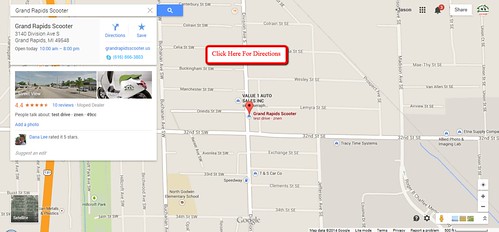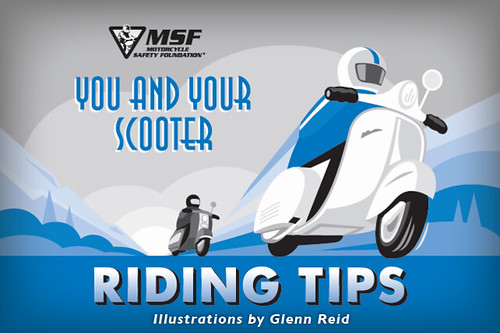Moped Trouble Shooting Tutorial
Introduction:
This guide is for mopeds only and will solve about 90% of the problems people encounter when trying to fix their mopeds. If you own a scooter that doesn't have pedals such as a honda express or vespa the following manual doesn't apply, only motorized bicycles are covered here.
Before you begin:
All mopeds are metric, you will therefore need some basic metric tools. This list describes some of the tools you may need:
- Socket size 8,9,10,11,12,13,14,16,18,20,22 mm
- Wrench sizes 8,9,10,11,12,13,14,16,18,20,22 mm
- Spark plug wrench
- Screw drivers (flat and philips)
- Pliers
- Carburator cleaner and penetrating oil such as WD-40
- Shadey Tree
Start Trouble Shooting Here.
All moped repairs begin with trouble shooting. The following outline describes the most common symptoms.
- Engine doesn't turn over, Frozen, Siezed.
- No spark or weak spark.
- No fuel flow or insufficient fuel flow.
- Low power, doesn't idle properly, bogs on low or high rpm's, runs poorly.
If your moped falls into any of the above catagories, this manual will help you get you 'ped up and running.
Step 1 Testing for spark and fuel flow.
Follow these instructions even if you think there is no spark !!!!!!
- Remove spark plug.
- Spray carberator cleaner into cylinder head as fuel.
- Install NEW spark plug and replace spark plug cap.
- Initiate starting sequence. (Peddle like hell.)
- Repeat if necessary to determine if engine runs.
Note: I have repaired a hundered or more mopeds using this guide line.
At this point one of two things will happen:
- If your moped runs until the carb cleaner is depleted and then dies you need to check the fuel flow (go to Step 2).
- If your moped doesn't run you need to check for a strong spark (go to Step 3).
Step 2 Checking for fuel flow. The most common problem!
The most common problem with mopeds is thay have been stored for a long period of time with fuel inside. The fuel turns bad and clogs the bikes natural fuel flow. In most cases the carburetor will need to be rebuilt (or I should say cleaned) and the bad fuel drained, in some cases the fuel turns into a varnish in which case you will need to flush out the fuel tank and clean or replace the fuel valve as well.
Fuel flow in a basic moped is very simple. Fuel travels from the gas tank through a fuel valve and fuel line to the carburetor where it enters a float bowl. From there the fuel is sucked through a fuel jet by the venturi effect and mixed with air and injected into the crank case (not the combustion chamber but just behind the piston. This is how all 2-stroke mopeds lubricate the bottom end). From the crank case the air/fuel mixture enters the cylinder head through a port that travels up the inside of the head and is burnt, then exits through the exhaust port.
- Remove fuel line from carburetor and check the fuel flow through the fuel valve. Clean or replace the valve if necessary.
- Inspect fuel tank and flush if necessary.
- Remove and rebuild the carburetor using a solvent, like carburetor cleaner. Do not use gas.
- Reassemble fuel system useing a NEW fuel line and filter.
- Test the brakes before you go flying down your driveway.
Step 3 Checking for spark.
There are about seven electrical components on the average moped ignition system. they are:
- Spark plug.
- Spark plug cap and wire.
- High voltage coil.
- Contact breaker points.
- Kill/Run switch.
- Magneto.
- Tail Lights ?
Now you may be wondering why I put tail lights on this list. Most people wouldn't think that the tail lights would be on the ignition system but they are. Much like on a car where the horn is on the brake light system so you can test your horn to see if the fuse to the brake lights is working, some moped engines won't run unless the tail light is working properly.
Step 4 Tail lights.
To test to see if the tail light maybe the problem.
- Install a NEW tail light or,
- Ground the tail light wire.
- Tomos mopeds ground the blue wire.
- Puch mopeds ground the blue/black wire.
- Peugeot mopeds ground the black wire.
Now go back to step 1 to see if this did the trick.
Step 5 Kill/Run Switch.
Mopeds don't have keys, they have kill switches. All the kill switch does is ground the ignition system. Sometimes the wire or the switch itself will become grounded. The test to see if the switch is the problem is to simply disconect the switch from the system. It's best to disconect it as close to the engine as possable. Follow the wire from the switch down the frame to the engine and disconnect it.
- Remove the kill switch from the ignition system.
Back to step 1
Step 6 Contact breaker points.
Up to this point I have presented you with the most common problems and their solutions so if you have gone through the first five steps and your moped still doesn't run then it's time to test the points to see if thay are opening. There are two ways to do this.
- Visuaily look at the points and rotate the flywheel until the piston reaches top dead center.
- Electronicly with a ohm meter.
Back to step 1
Step 7 Spark plug cap and wire
If you have come this far and your moped still isn't running then it's time to replace the spark plug cap and wire. The spark plug cap and wire only cost a few bucks to replace and there's really no easy way to test them unless you have a cap and wire that you know are good.
- Replace spark plug cap and wire with ones you know are good.
Back to step 1
General Maintenance Tips for Mopeds Scooters
Carburetor:
The carburetor has many adjustments on it and it is recommended that these adjustments to be made by experienced persons only, however we will point out the major points. The carburetor is responsible for pumping the fuel and mixing it with the air at a precise measurement. The carburetor does this with very small diaphragms, orifices and ports, which are easily clogged by contaminants. This is why is extremely important that you use only clean new fuel in your gas scooter.
The brass color screw located lower on the side of the carburetor next to the choke lever is for the high speed mixture. Start by turning this screw in (clockwise) until it stops. Don't turn it in tight, just until it stops. Next, turn the screw out two full turns (counter-clockwise). This is the factory setting. You should be able to start and operate the scooter with this setting. Once you have it running, you can fine tune. Never turn the screw more than 1/8 of a turn at a time. Try turning it IN about 1/8, this will help the top speed
operation. BUT, turning it in TOO MUCH will cause the motor to run lean at full speed and can burn a piston. Also, running too lean will cause a loss of low end power. Once you get the mixture set you can adjust the idle, it should be low enough that the engine doesn't vibrate. Finally make sure you have the choke lever down completely after the scooter is started and warmed up.
There is also a main jet adjustment screw dead center on the top of the carburetor. This is most always set at 1 full turn out. If this is not adjusted correctly, your scooter may not run, or run very poorly. Once again, turn screw all the way in (clockwise) and then out (counter-clockwise) 360 degrees (1 full turn).
The small gold screw on the side of the carburetor is the idle speed screw. This screw controls the idle speed, the tip should extend about an 1/8 of an inch (4 mm). Adjust it so the engine will idle at just fast enough speed to stay running.
Idle:
If the scooter will not idle or idles too fast, an adjustment screw is provided next to the choke. Turning this screw clockwise will increase the idle speed. Turning the screw counterclockwise will decrease the idle speed. Remember that an idle speed that is too fast can be dangerous.
Spark Plug:
The spark plug is a crucial and vulnerable part on your engine. Your spark plug can be located on the top of the engine under the protective rubber boot. Your scooter comes with a tool kit containing a spark plug wrench for easy removal. The spark plug must be clean, and must be replaced promptly when signs of wear begin to show. The condition of the spark plug can tell you a lot about how your motor is running. If the electrode is white, that can be a sign that your scooter is running too hot. This can be a result of either running too lean, or that the fuel and air mixture is too lean. If you are running your scooter to rich then your spark plug may be black, covered with gas, oil, or carbon. Another common problem is that the spark plug gets clogged up with carbon and/or oil and "fouls". This should be checked by assuring the electrode has a clean gap of .023 in.
Air Filter:
The air filter is used to clean the air going into the engine. Periodic cleaning of this filter is recommended to protect your gas scooter engine against the damaging effects of dirt and abrasive particulates. Your air filter can be located on the front of the engine and the protective cover can be removed with one screw. When the protective cover is removed the air filter is revealed. You can also see the small workings of the choke and butterfly valve. The filter should be free from dirt and grease and appear clean like the one shown on the right. If
there are contaminants on the filter it can be cleaned in a container of gasoline. Allow the filter to dry before re-installing it into your gas scooter.
Throttle:
There are two main types of scooter throttles. One is a twist type, and the other is a hand throttle. Although the throttles are different in operation, they are essentially mechanically the same. When the rider applies the throttle, a cable carries this motion down to the engine. For continued smooth operation it is important to keep this cable clean and free of obstructions. Should the throttle begin to feel loose and sloppy, the slack can be adjusted on the cable at the handlebars. Simply loosen the lock nut and adjust the cable tension via the adjustment screw. Once the desired tension is achieved retighten the lock nut.
Brakes:
The easiest way to adjust your brakes is on the handbrake itself. This adjustment has two simple steps. To change the tension on the cable merely back off the locking nut and screw the adjustment screw in or out accordingly. Once the desired tension is achieved re-tighten the locking nut
Proper Scooter maintenance is crucial to getting the most out of your scooter. You should always consult your owner’s manual as the following tips may vary from scooter to scooter. If the information presented here contradicts your owner manual, then you should trust the manufacture and abide by their specs. Furthermore we remind scooter enthusiasts to follow safe riding practices and ALWAYS wear protective gear.








